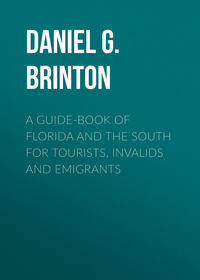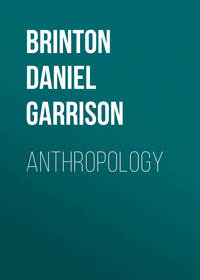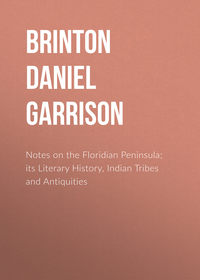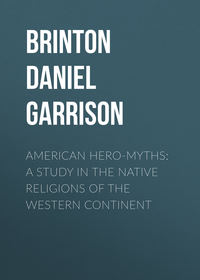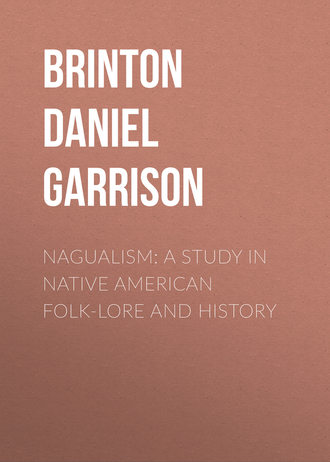 полная версия
полная версияNagualism: A Study in Native American Folk-lore and History

Daniel G. Brinton
Nagualism: A Study in Native American Folk-lore and History
1. The words, a nagual, nagualism, a nagualist, have been current in English prose for more than seventy years; they are found during that time in a variety of books published in England and the United States,1 yet are not to be discovered in any dictionary of the English language; nor has Nagualism a place in any of the numerous encyclopædias or “Conversation Lexicons,” in English, French, German or Spanish.
This is not owing to its lack of importance, since for two hundred years past, as I shall show, it has been recognized as a cult, no less powerful than mysterious, which united many and diverse tribes of Mexico and Central America into organized opposition against the government and the religion which had been introduced from Europe; whose members had acquired and were bound together by strange faculties and an occult learning, which placed them on a par with the famed thaumaturgists and theodidacts of the Old World; and which preserved even into our own days the thoughts and forms of a long suppressed ritual.
In several previous publications I have referred briefly to this secret sodality and its aims,2 and now believe it worth while to collect my scattered notes and present all that I have found of value about the origin, aims and significance of this Eleusinian Mystery of America. I shall trace its geographical extension and endeavor to discover what its secret influence really was and is.
2. The earliest description I find of its particular rites is that which the historian Herrera gives, as they prevailed in 1530, in the province of Cerquin, in the mountainous parts of Honduras. It is as follows:
“The Devil was accustomed to deceive these natives by appearing to them in the form of a lion, tiger, coyote, lizard, snake, bird, or other animal. To these appearances they apply the name Naguales, which is as much as to say, guardians or companions; and when such an animal dies, so does the Indian to whom it was assigned. The way such an alliance was formed was thus: The Indian repaired to some very retired spot and there appealed to the streams, rocks and trees around him, and weeping, implored for himself the favors they had conferred on his ancestors. He then sacrificed a dog or a fowl, and drew blood from his tongue, or his ears, or other parts of his body, and turned to sleep. Either in his dreams or half awake, he would see some one of those animals or birds above mentioned, who would say to him, ‘On such a day go hunting and the first animal or bird you see will be my form, and I shall remain your companion and Nagual for all time.’ Thus their friendship became so close that when one died so did the other; and without such a Nagual the natives believe no one can become rich or powerful.”3
This province of Cerquin appears to have been peopled by a tribe which belonged to the great Mayan stock, akin to those which occupied most of the area of what is now Yucatan, Tabasco, Chiapas and Guatemala.4 I shall say something later about the legendary enchantress whom their traditions recalled as the teacher of their ancestors and the founder of their nation. What I would now call attention to is the fact that in none of the dialects of the specifically Mexican or Aztecan stock of languages do we find the word nagual in the sense in which it is employed in the above extract, and this is strong evidence that the origin of Nagualism is not to be sought in that stock.
3. We do find, however, in the Nahuatl language, which is the proper name of the Aztecan, a number of derivatives from the same root, na, among them this very word, Nahuatl, all of them containing the idea “to know,” or “knowledge.” The early missionaries to New Spain often speak of the naualli (plural, nanahualtin), masters of mystic knowledge, dealers in the black art, wizards or sorcerers. They were not always evil-minded persons, though they seem to have been generally feared. The earliest source of information about them is Father Sahagun, who, in his invaluable History, has the following paragraph:
“The naualli, or magician, is he who frightens men and sucks the blood of children during the night. He is well skilled in the practice of this trade, he knows all the arts of sorcery (nauallotl) and employs them with cunning and ability; but for the benefit of men only, not for their injury. Those who have recourse to such arts for evil intents injure the bodies of their victims, cause them to lose their reason and smother them. These are wicked men and necromancers.”5
It is evident on examining the later works of the Roman clergy in Mexico that the Church did not look with any such lenient eye on the possibly harmless, or even beneficial, exercise of these magical devices. We find a further explanation of what they were, preserved in a work of instruction to confessors, published by Father Juan Bautista, at Mexico, in the year 1600.
“There are magicians who call themselves teciuhtlazque,6 and also by the term nanahualtin, who conjure the clouds when there is danger of hail, so that the crops may not be injured. They can also make a stick look like a serpent, a mat like a centipede, a piece of stone like a scorpion, and similar deceptions. Others of these nanahualtin will transform themselves to all appearances (segun la aparencia), into a tiger, a dog or a weasel. Others again will take the form of an owl, a cock, or a weasel; and when one is preparing to seize them, they will appear now as a cock, now as an owl, and again as a weasel. These call themselves nanahualtin.”7
There is an evident attempt in this somewhat confused statement to distinguish between an actual transformation, and one which only appears such to the observer.
In another work of similar character, published at Mexico a few years later, the “Road to Heaven,” of Father Nicolas de Leon, we find a series of questions which a confessor should put to any of his flock suspected of these necromantic practices. They reveal to us quite clearly what these occult practitioners were believed to do. The passage reads as follows, the questions being put in the mouth of the priest:
“Art thou a soothsayer? Dost thou foretell events by reading signs, or by interpreting dreams, or by water, making circles and figures on its surface? Dost thou sweep and ornament with flower garlands the places where idols are preserved? Dost thou know certain words with which to conjure for success in hunting, or to bring rain?
“Dost thou suck the blood of others, or dost thou wander about at night, calling upon the Demon to help thee? Hast thou drunk peyotl, or hast thou given it to others to drink, in order to find out secrets, or to discover where stolen or lost articles were? Dost thou know how to speak to vipers in such words that they obey thee?”8
4. This interesting passage lets in considerable light on the claims and practices of the nagualists. Not the least important item is that of their use of the intoxicant, peyotl, a decoction of which it appears played a prominent part in their ceremonies. This is the native Nahuatl name of a certain plant, having a white, tuberous root, which is the part employed. It is mentioned as “pellote” or “peyote” in the Farmacopea Mexicana as a popular remedy, but its botanical name is not added. According to Paso y Troncoso, it is one of the Compositæ, a species of the genus Cacalia.9 It is referred to in several passages by Father Sahagun, who says that it grows in southern Mexico, and that the Aztecs derived their knowledge of it from the older “Chichimecs.” It was used as an intoxicant.
“Those who eat or drink of this peyotl see visions, which are sometimes frightful and sometimes ludicrous. The intoxication it causes lasts several days. The Chichimecs believed that it gave them courage in time of danger and diminished the pangs of hunger and thirst.”10
Its use was continued until a late date, and very probably has not yet died out. Its composition and method of preparation are given in a list of beverages prohibited by the Spanish authorities in the year 1784, as follows:
“Peyote: Made from a species of vinagrilla, about the size of a billiard ball, which grows in dry and sterile soil. The natives chew it, and throw it into a wooden mortar, where it is left to ferment, some leaves of tobacco being added to give it pungency. They consume it in this form, sometimes with slices of peyote itself, in their most solemn festivities, although it dulls the intellect and induces gloomy and hurtful visions (sombras muy funestas).”11
The peyotl was not the only herb prized as a means of casting the soul into the condition of hypostatic union with divinity. We have abundant evidence that long after the conquest the seeds of the plant called in Nahuatl the ololiuhqui were in high esteem for this purpose. In the Confessionary of Father Bartholomé de Alva the priest is supposed to inquire and learn as follows:
“Question. Hast thou loved God above all things? Hast thou loved any created thing, adoring it, looking upon it as God, and worshiping it?
“Answer. I have loved God with all my heart; but sometimes I have believed in dreams, and also I have believed in the sacred herbs, the peyotl, and the ololiuhqui; and in other such things (onicneltocac in temictli, in xiuhtzintli, in peyotl, in ololiuhqui, yhuan in occequitlamantli).”12
The seeds of the ololiuhqui appear to have been employed externally. They were the efficient element in the mysterious unguent known as “the divine remedy” (teopatli), about which we find some information in the works of Father Augustin de Vetancurt, who lived in Mexico in the middle of the seventeenth century. He writes:
“The pagan priests made use of an ointment composed of insects, such as spiders, scorpions, centipedes and the like, which the neophytes in the temples prepared. They burned these insects in a basin, collected the ashes, and rubbed it up with green tobacco leaves, living worms and insects, and the powdered seeds of a plant called ololiuhqui, which has the power of inducing visions, and the effect of which is to destroy the reasoning powers. Under the influence of this ointment, they conversed with the Devil, and he with them, practicing his deceptions upon them. They also believed that it protected them, so they had no fear of going into the woods at night.
“This was also employed by them as a remedy in various diseases, and the soothing influence of the tobacco and the ololiuhqui was attributed by them to divine agency. There are some in our own day who make use of this ointment for sorcery, shutting themselves up, and losing their reason under its influence; especially some old men and old women, who are prepared to fall an easy prey to the Devil.”13
The botanist Hernandez observes that another name for this plant was coaxihuitl, “serpent plant,” and adds that its seeds contain a narcotic poison, and that it is allied to the genus Solanum, of which the deadly night-shade is a familiar species. He speaks of its use in the sacred rites in these words:
“Indorum sacrifici, cum videri volebant versari cum superis, ac responsa accipere ab eis, ea vescebantur planta, ut desiperent, milleque phantasmata et demonum observatium effigies circumspectarent.”14
Of the two plants mentioned, the ololiuhqui and the peyotl, the former was considered the more potent in spiritual virtues. “They hold it in as much veneration as if it were God,” says a theologian of the seventeenth century.15 One who partook of these herbs was called payni (from the verb pay, to take medicine); and more especially tlachixqui, a Seer, referring to the mystic “second sight,” hence a diviner or prophet (from the verb tlachia, to see).
Tobacco also held a prominent, though less important, place in these rites. It was employed in two forms, the one the dried leaf, picietl, which for sacred uses must be broken and rubbed up either seven or nine times; and the green leaf mixed with lime, hence called tenextlecietl (from tenextli, lime).
Allied in effect to these is an intoxicant in use in southern Mexico and Yucatan, prepared from the bark of a tree called by the Mayas baal-che. The whites speak of the drink as pitarilla. It is quite popular among the natives, and they still attribute to it a sacred character, calling it yax ha, the first water, the primal fluid. They say that it was the first liquid created by God, and when He returned to His heavenly home He left this beverage and its production in charge of the gods of the rains, the four Pah-Ahtuns.16
5. Intoxication of some kind was an essential part of many of these secret rites. It was regarded as a method of throwing the individual out of himself and into relation with the supernal powers. What the old historian, Father Joseph de Acosta, tells us about the clairvoyants and telepaths of the aborigines might well stand for a description of their modern representatives:
“Some of these sorcerers take any shape they choose, and fly through the air with wonderful rapidity and for long distances. They will tell what is taking place in remote localities long before the news could possibly arrive. The Spaniards have known them to report mutinies, battles, revolts and deaths, occurring two hundred or three hundred leagues distant, on the very day they took place, or the day after.
“To practice this art the sorcerers, usually old women, shut themselves in a house, and intoxicate themselves to the degree of losing their reason. The next day they are ready to reply to questions.”17
Plants possessing similar powers to excite vivid visions and distort the imagination, and, therefore, employed in the magical rites, were the thiuimeezque, in Michoacan, and the chacuaco, in lower California.18
6. In spite of all effort, the various classes of wonder-workers continued to thrive in Mexico. We find in a book of sermons published by the Jesuit Father, Ignacio de Paredes, in the Nahuatl language, in 1757, that he strenuously warns his hearers against invoking, consulting, or calling upon “the devilish spell-binders, the nagualists, and those who conjure with smoke.”19
They have not yet lost their power; we have evidence enough that many children of a larger growth in that land still listen with respect to the recitals of the mysterious faculties attributed to the nanahualtin. An observant German traveler, Carlos von Gagern, informs us that they are widely believed to be able to cause sicknesses and other ills, which must be counteracted by appropriate exorcisms, among which the reading aloud certain passages of the Bible is deemed to be one of the most potent.20
The learned historian, Orozco y Berra, speaks of the powers attributed at the present day to the nahual in Mexico among the lower classes, in these words:
“The nahual is generally an old Indian with red eyes, who knows how to turn himself into a dog, woolly, black and ugly. The female witch can convert herself into a ball of fire; she has the power of flight, and at night will enter the windows and suck the blood of little children. These sorcerers will make little images of rags or of clay, then stick into them the thorn of the maguey and place them in some secret place; you can be sure that the person against whom the conjuration is practiced will feel pain in the part where the thorn is inserted. There still exist among them the medicine-men, who treat the sick by means of strange contortions, call upon the spirits, pronounce magical incantations, blow upon the part where the pain is, and draw forth from the patient thorns, worms, or pieces of stone. They know how to prepare drinks which will bring on sickness, and if the patients are cured by others the convalescents are particular to throw something of their own away, as a lock of hair, or a part of their clothing. Those who possess the evil eye can, by merely looking at children, deprive them of beauty and health, and even cause their death.”21
7. As I have said, nowhere in the records of purely Mexican, that is, Aztecan, Nagualism do we find the word nagual employed in the sense given in the passage quoted from Herrera, that is as a personal guardian spirit or tutelary genius. These tribes had, indeed, a belief in some such protecting power, and held that it was connected with the day on which each person is born. They called it the tonalli of a person, a word translated to mean that which is peculiar to him, which makes his individuality, his self. The radical from which it is derived is tona, to warm, or to be warm, from which are also derived tonatiuh, the sun. Tonalli, which in composition loses its last syllable, is likewise the word for heat, summer, soul, spirit and day, and also for the share or portion which belongs to one. Thus, to-tonal is spirit or soul in general; no-tonal, my spirit; no-tonal in ipan no-tlacat, “the sign under which I was born,” i. e., the astrological day-sign. From this came the verb tonalpoa, to count or estimate the signs, that is, to cast the horoscope of a person; and tonalpouhque, the diviners whose business it was to practice this art.22
These tonalpouhque are referred to at length by Father Sahagun.23 He distinguishes them from the naualli, though it is clear that they corresponded in functions to the nagualistic priests of the southern tribes. From the number and name of the day of birth they forecast the destiny of the child, and stated the power or spiritual influence which should govern its career.
The tonal was by no means an indefeasible possession. It was a sort of independent mascotte. So long as it remained with a person he enjoyed health and prosperity; but it could depart, go astray, become lost; and then sickness and misfortune arrived. This is signified in the Nahuatl language by the verbs tonalcaualtia, to check, stop or suspend the tonal, hence, to shock or frighten one; and tonalitlacoa, to hurt or injure the tonal, hence, to cast a spell on one, to bewitch him.
This explains the real purpose of the conjuring and incantations which were carried on by the native doctor when visiting the sick. It was to recall the tonal, to force or persuade it to return; and, therefore, the ceremony bore the name “the restitution of the tonal,” and was more than any other deeply imbued with the superstitions of Nagualism. The chief officiant was called the tetonaltiani, “he who concerns himself with the tonal.” On a later page I shall give the formula recited on such an occasion.
8. There is some vague mention in the Aztec records of a semi-priestly order, who bore the name naualteteuctin, which may be translated “master magicians.” They were also known as teotlauice, “sacred companions in arms.” As was the case with most classes of the teteuctin, or nobles, entrance to the order was by a severe and prolonged ceremony of initiation, the object of which was not merely to test the endurance of pain and the powers of self-denial, but especially to throw the mind into that subjective state in which it is brought into contact with the divine, in which it can “see visions and dream dreams.” The order claimed as its patron and founder Quetzalcoatl, the “feathered serpent,” who, it will be seen on another page, was also the patron of the later nagualists.24
The word naualli also occurs among the ancient Nahuas in composition as a part of proper names; always with the signification of “magician,” as in that of Naualcuauhtla, a chief of the Chalcos, meaning “wizard-stick,” referring probably to the rod or wand employed by the magi in conjuration.25 So also Naualac, the “wizard water,” an artificial lake not far from the city of Mexico, surrounded by ruined temples, described by M. Charnay.26
9. The belief in a personal guardian spirit was one of the fundamental doctrines of Nagualism; but this belief by no means connotes the full import of the term (as Mr. H. H. Bancroft has erroneously stated). The calendar system of Mexico and Central America, which I have shown to be substantially the same throughout many diverse linguistic stocks,27 had as one of its main objects, astrological divination. By consulting it the appropriate nagual was discovered and assigned, and this was certainly a prominent feature in the native cult and has never been abandoned.
In Mexico to-day, in addition to his special personal guardian, the native will often choose another for a limited time or for a particular purpose, and this is quite consistent with the form of Christianity he has been taught. For instance, as we are informed by an observant traveler, at New Year or at corn-planting the head of a family will go to the parish church and among the various saints there displayed will select one as his guardian for the year. He will address to him his prayers for rain and sunshine, for an abundant harvest, health and prosperity, and will not neglect to back these supplications by liberal gifts. If times are good and harvests ample the Santo is rewarded with still more gifts, and his aid is sought for another term; but if luck has been bad the Indian repairs to the church at the end of the year, bestows on his holy patron a sound cursing, calls him all the bad names he can think of, and has nothing more to do with him.28
10. A Mexican writer, Andres Iglesias, who enjoyed more than common opportunities to study these practices as they exist in the present generation, describes them as he saw them in the village of Soteapan, a remote hamlet in the State of Vera Cruz, the population of which speak the Mixe language. This is not related to the Nahuatl tongue, but the terms of their magical rites are drawn from Nahuatl words, showing their origin. Every person at birth has assigned to him both a good and a bad genius, the former aiming at his welfare, the latter at his injury. The good genius is known by the Nahuatl term tonale, and it is represented in the first bird or animal of any kind which is seen in or near the house immediately after the birth of the infant.
The most powerful person in the village is the high priest of the native cult. One who died about 1850 was called “the Thunderbolt,” and whenever he walked abroad he was preceded by a group of chosen disciples, called by the Nahuatl name tlatoques, speakers or attorneys.29 His successor, known as “the Greater Thunder,” did not maintain this state, but nevertheless claimed to be able to control the seasons and to send or to mitigate destructive storms – claims which, sad to say, brought him to the stocks, but did not interfere with the regular payment of tribute to him by the villagers. He was also a medicine man and master of ceremonies in certain “scandalous orgies, where immodesty shows herself without a veil.”30
11. Turning to the neighboring province of Oaxaca and its inhabitants, we are instructed on the astrological use of the calendar of the Zapotecs by Father Juan de Cordova, whose Arte of their language was published at Mexico in 1578. From what he says its principal, if not its only purpose, was astrological. Each day had its number and was called after some animal, as eagle, snake, deer, rabbit, etc. Every child, male or female, received the name of the day, and also its number, as a surname; its personal name being taken from a fixed series, which differed in the masculine and feminine gender, and which seems to have been derived from the names of the fingers.
From this it appears that among the Zapotecs the personal spirit or nagual was fixed by the date of the birth, and not by some later ceremony, although the latter has been asserted by some writers; who, however, seem to have applied without certain knowledge the rites of the Nahuas and other surrounding tribes to the Zapotecs.31






